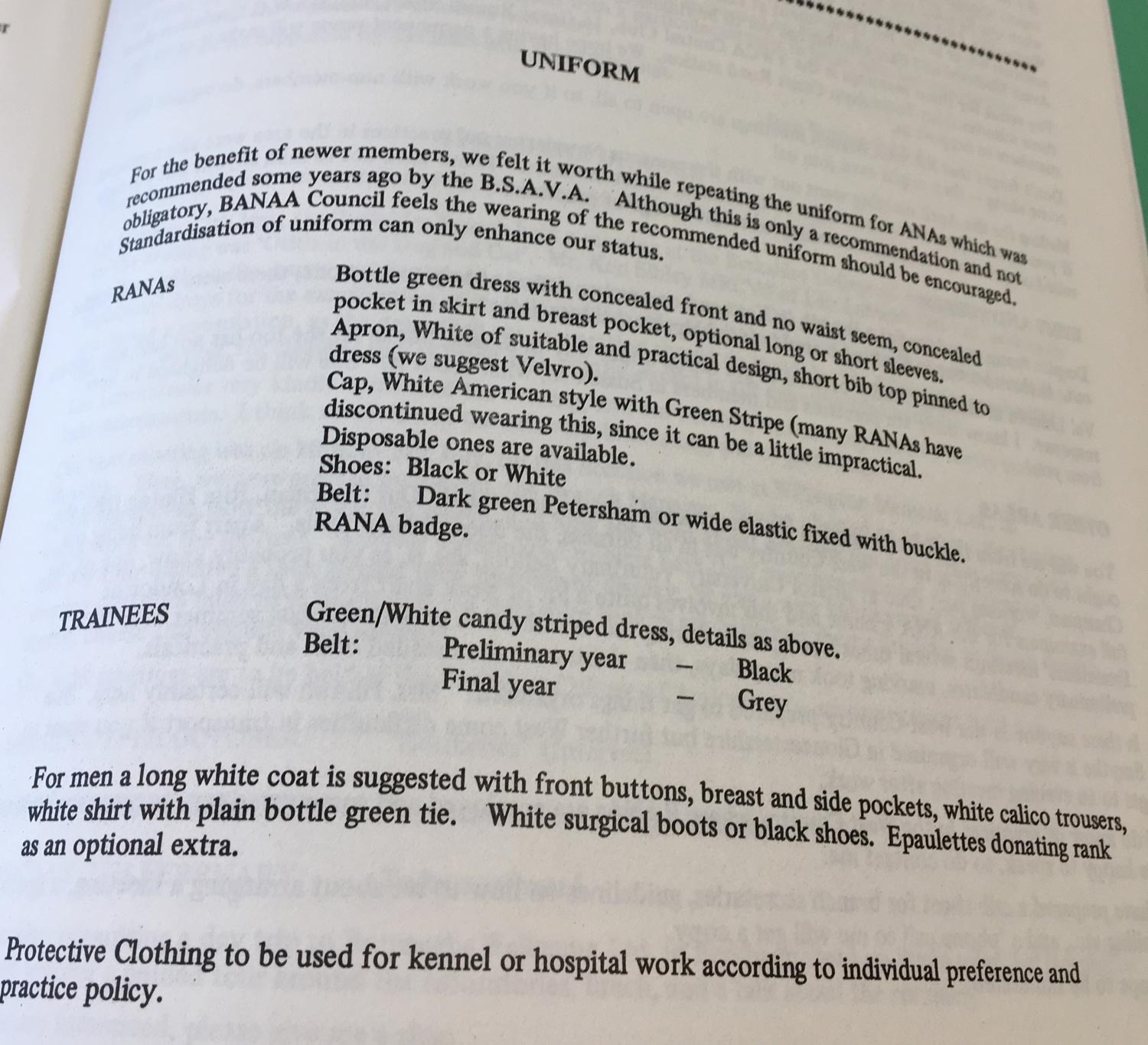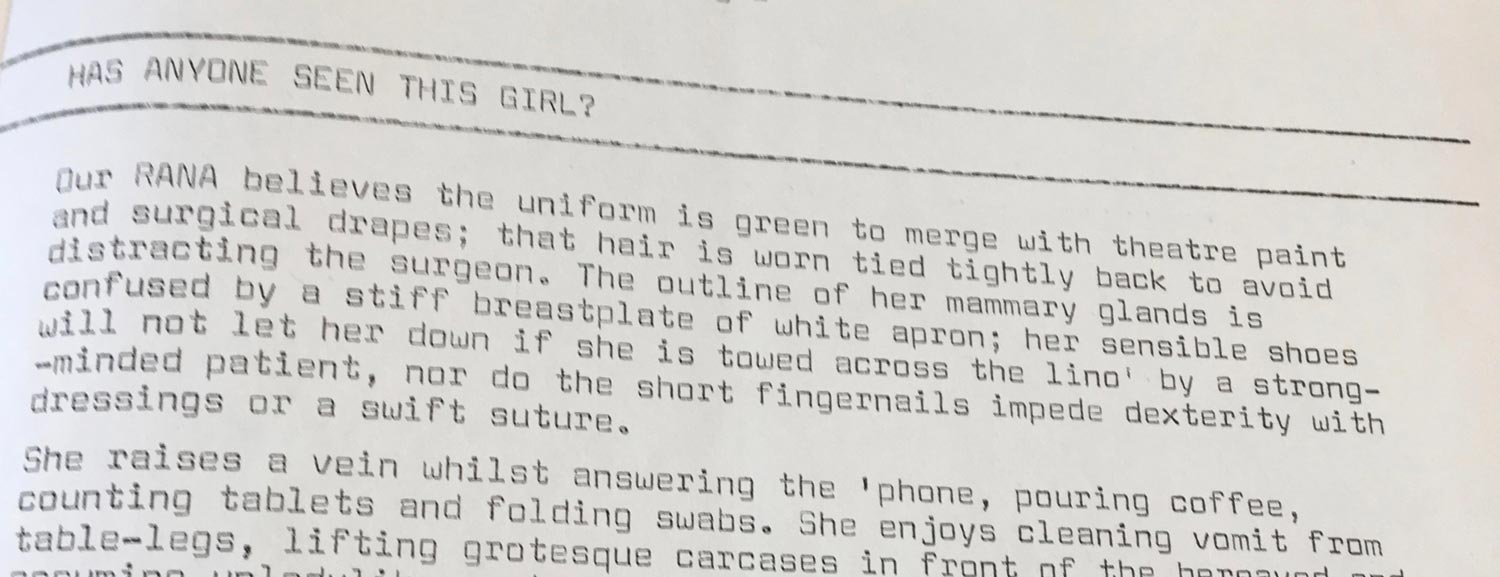I’m in a bit of a rut – I’ll apologise for that now. There’s a bit of a theme coming out in my current writing; it’s all about our identity, or lack thereof, as seen from different viewpoints.

I started digging into this subject at the beginning of the year (Are vet nurses hidden in plain sight?) and the more I look into it the more I’m finding patterns.
I’ve looked at why we are hard to see financially (Credit where credit’s due) and I’ve also looked at how we present ourselves for hygiene purposes (Uniform policy and infection control).
However, once past the hygiene aspect of our uniform, does what we wear make us out as a separate professional in practice? Do we know what the public thinks? In fact, what does it recognise as a veterinary nurse?
Colour coding
I’ve started doing some research into a question I’ve often pondered – why is green associated with the role?
There are numerous mentions of the veterinary nurse’s uniform from the early days of the profession, including a reference to the 1969 BSAVA Congress, where there was a stand showing the “new vet nurse uniform”.
I’ve also checked the British Animal Nursing Auxiliaries Association (BANAA) archives at the BVNA and found some interesting reading. It would appear the decision to wear bottle green originally came from the BSAVA and, in August 1982, it was noted by BANAA that, although it would not enforce it, the colour scheme was recommended.

I am also working with the BSAVA to find out more information. So far we’ve checked the archives back to 1967, where I hoped there would be more information. However, there wasn’t anything.
Amazingly, the BSAVA is in the process of digitising the archives so more research can be done. I would ideally like to find out the origin of the colour green – as many people are very attached to it.
Colour theories
 I’ve heard a couple of theories about the chosen colour. The first came from BVNA president Sam Morgan, who told me she’d heard we were in green because our original title of Registered Animal Nursing Auxiliary used the acronym RANA, which was Latin for frog.
I’ve heard a couple of theories about the chosen colour. The first came from BVNA president Sam Morgan, who told me she’d heard we were in green because our original title of Registered Animal Nursing Auxiliary used the acronym RANA, which was Latin for frog.
I discovered another (rather tongue-in-cheek) theory in the BANAA files that suggested the RANA wears green to “blend in” and not be seen (below). In fact, her attire (note the assumption all RANAs will be female) is deliberately chosen in an attempt to not “distract” the vet – who undoubtedly has been assumed to be male.
This was written in the 1980s, so not all that long ago…

Media matters
I’ve rarely worked in a practice that insisted on traditional greens, so maybe I’m not that attached to them, but the importance of the colour for others was brought home to me by a couple of media events.
The first was last year when RCVS VN council chairman Liz Cox and I appeared on BBC London News to talk about the RCVS petition to protect the title of “veterinary nurse”. It was great exposure and we got a good response, so I posted the clip on Facebook for those not in the London area. For the most part, people seemed really pleased, except for one comment that wasn’t 100% behind us.
What was wrong? Yes, it was what I wore. I had on black scrubs and, despite the lead-in being about veterinary nurses, one person said they didn’t recognise me as a veterinary nurse because I wasn’t wearing green. I’ll admit my badge couldn’t be seen, but hasten to add our badges were cropped out, even though we mentioned them a lot, pointed to them and felt they surely couldn’t edit round that….
They did!
Decent exposure
Secondly, we had the privilege of having an RVN appear on a high profile TV show, working independently of a vet. RVN Nim Patel, founder of the British Association of Veterinary Nursing Students (BAVNS), was the vet nurse correspondent for Channel 4’s Crufts 2017 coverage.
Now, whatever your opinion of Crufts, it’s a huge event for dog owners across the country and to get an RVN delivering two items each day on dog welfare was a huge breakthrough for the veterinary nursing profession.
Nim wore her badge and was introduced as a vet nurse each time, yet people were still asking about her clothing. She looked smart and respectable, and she wasn’t in a clinical setting, so I thought what she wore was perfect for a professional on TV.
There were vets on the same shows who weren’t dressed in scrubs, yet no one voiced the opinion that they needed specific clothing to identify them.
Out of office
This leads back to a point I’ve pondered before – do we not dilute the power of our medical uniform by wearing it in non-clinical settings?
Numerous studies support changing into and out of uniform at work and only wearing them in clinical settings – covering up if you need to go on a house visit or travel in uniform. The NHS has guidelines and has noted their main concern about uniforms being worn outside hospital premises is public perception of hygiene and professionalism. If we are to improve the respect for our profession, is making sure we wear our uniforms appropriately not part of this?
Is that more important than the colour? Does the colour green really matter so much?
I probably need to do an audit, but I’m sure people will tell me what they see – but vet TV shows don’t all have nurses in green. Frankly the whole issue of nurses on TV (human and veterinary) is a whole other blog, so I won’t get into it here.
For now, I’ll settle on getting confirmation about why green was chosen – are we frogs or were we to blend in?
This blog was only possible due to the patience of staff at BVNA HQ and Carole Haile at the BSAVA, who is searching through boxes for me even as you read this. Thank you to everyone who accepted my unusual requests with such openness.

Leave a Reply